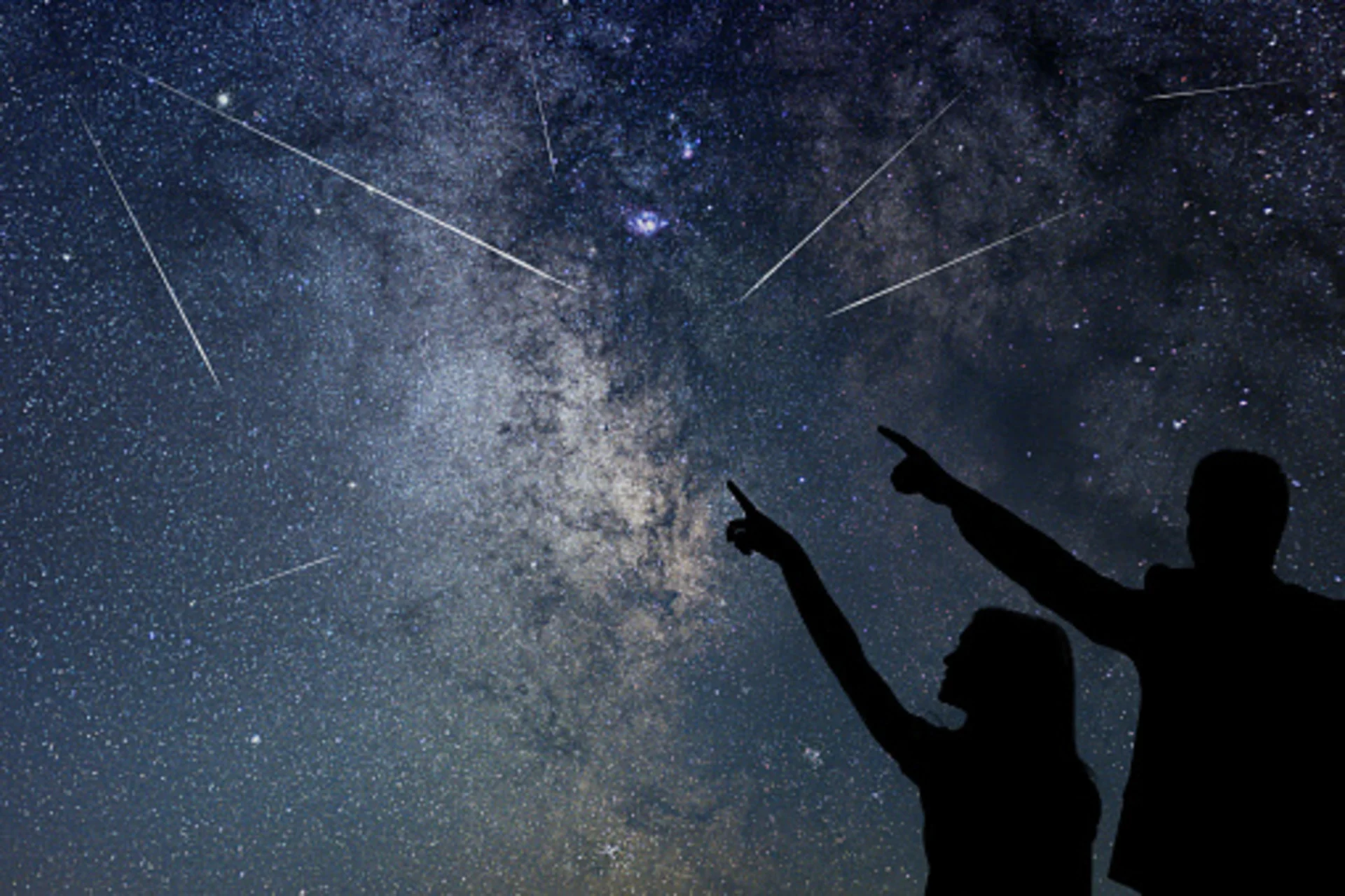
Overlapping meteor showers put on a show in the night sky this summer
The southern delta Aquariids and the Perseids combine this summer for a double meteor shower.
The nights may be shorter during the summer months, but they are just about the best time of year to stay up late and gaze at the night sky.
From the morning lineup of bright planets, to the closest supermoon of the year, the summer season will deliver some excellent skywatching opportunities. The highlight of the season, though, will likely be the overlapping meteor showers sending streaks of light across the night.
Here is our guide to the astronomical sights on display for Summer 2022.
Jun 21: Summer solstice (northern hemisphere)
Jun 22-27: Crescent Moon passes by predawn planet lineup
Jul 4: Earth at aphelion (farthest point from the Sun for 2022)
Jul 13: Super Buck Moon (largest Full Moon of 2022)
Jul 18-26: Crescent Moon passes by predawn planet lineup
Jul 28-29: southern delta Aquariid meteor shower peaks
Aug 12: Super Sturgeon Moon
Aug 12/13: Perseid meteor shower peak
Aug 14: Saturn at Opposition
Aug 15-16: Gibbous Moon passes by Jupiter
Aug 19-20: Crescent Moon passes by Mars
Sep 10: Full Corn Moon (Harvest Moon)
Sep 11-12: Gibbous Moon passes by Jupiter
Sep 16-17: Crescent Moon passes by Mars
Sep 22: Autumn Equinox (northern hemisphere)
Visit our Complete Guide to Summer 2022 for an in-depth look at the Summer Forecast, tips to plan for it and much more!
PLANETARY LINEUP
For all of spring, a lineup of planets — Venus, Mars, Jupiter, and Saturn — has been visible along the eastern horizon, in the hours just before sunrise.
Right at the start of summer, this lineup will still be there. However, it will be more stretched out across the sky, and with a new member added.

The six innermost planets of our solar system — Mercury, Venus, Mars, Jupiter, and Saturn strung out along the horizon (Earth) — are visible in this simulation of the predawn sky on June 22, 2022. Credit: Stellarium/Scott Sutherland
Starting on June 22, watch for Mercury to pop up above the horizon around 4:30 a.m., local time. It may be difficult to spot, depending on the sky conditions. Binoculars or a telescope will certainly help. You'll need to be quick, too, as it will only be visible for a short time before the bright dot is lost in the twilight of the approaching dawn.
Throughout the season, the lineup will change. Mercury will be lost to the glare of the Sun by early July, and the same will happen to Venus about a month later. Meanwhile, Mars, Jupiter and Saturn will get farther and farther apart, eventually leaving only Mars and Jupiter clearly visible in the predawn sky by September.
EARTH AT APHELION
On July 4, Earth will reach the farthest point from the Sun in its orbit for this year. This point is known as aphelion (pronounced ah-FEEL-ee-on).
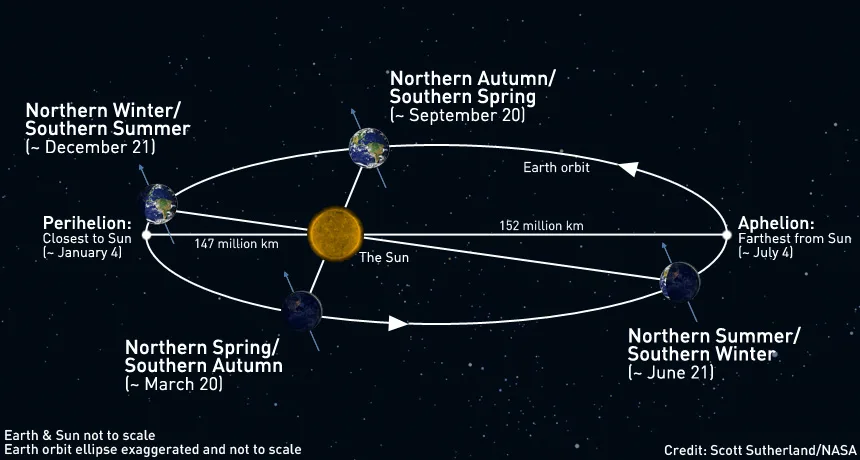
Earth's orbit around the Sun, noting the Solstices, Equinoxes and the timing of perihelion and aphelion. The image is not to scale. Credit: Scott Sutherland/NASA
We often talk about Earth 'circling' the Sun. However, our planet doesn't trace out a perfect circle as it travels in its yearly orbit around our home star. Instead, it follows an egg-shaped 'elliptical' path, as shown in exaggerated detail in the diagram above.
Earth's average distance from the Sun (1 astronomical unit, or 1 AU) is around 150 million kilometres. Perihelion, Earth's closest point to the Sun during any year, usually takes place around January 4, plus or minutes a day or so. Aphelion, on the other hand, occurs around July 4 each year. While the planet's average distance at perihelion is around 147 million km and the average aphelion distance is around 152 million km, the exact distances change from year to year.
From TimeandDate.com, Earth was 147,105,052 km away from the Sun during Perihelion 2022, which occurred at 1:52 a.m. EST, on January 4. Aphelion 2022 happens at 3:10 a.m. EDT on July 4, at a distance of 152,098,455 km.
You won't feel anything or see anything as this happens. Perihelion and aphelion do not even have much of an effect on our seasons (which are caused by Earth's tilt). Still, perhaps pause for just a moment at the appropriate time, to mark the passing of this orbital milestone.
SUMMER MOONS
The first Full Moon of summer is going to be one you won't want to miss!
July's Full Buck Moon, which rises on the night of July 13, is 2022's perigee supermoon — the biggest and brightest we've seen all year so far.
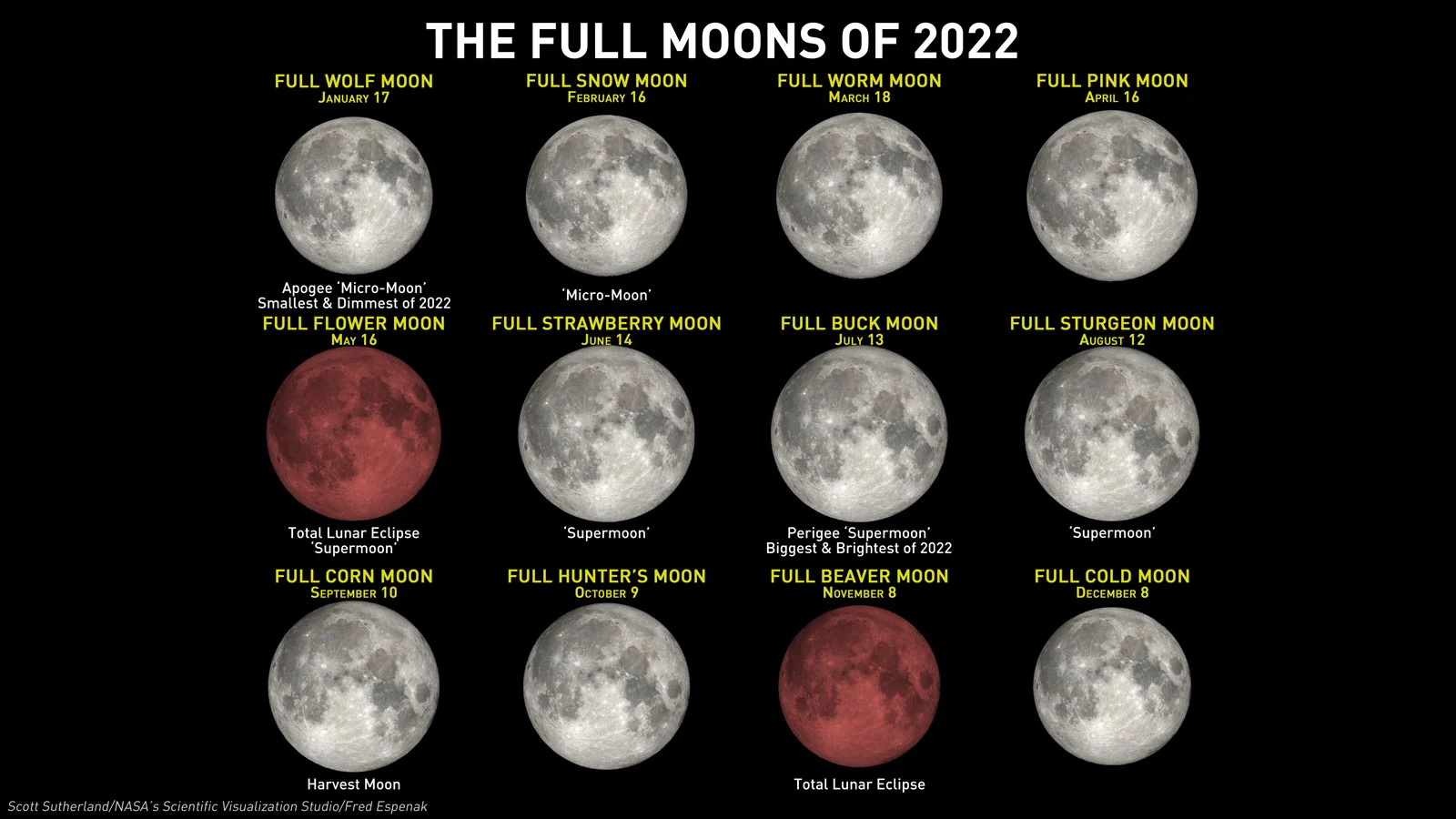
The 12 Full Moons of 2022, including their popular names and any other notable facts — supermoons, micromoons, lunar eclipses, etc. Credit: Scott Sutherland/NASA GSFC, with data from Fred Espenak
Earth's Moon doesn't trace out a perfect circle as it orbits the planet. Instead, its orbit is ever-so-slightly elliptical. So, sometimes it's closer to us, and when it is at its closest we say that it is at perigee. Other times, the Moon is farther away, and we call its farthest distance apogee. Due to the influence of the Sun and the other planets, perigee and apogee vary with each orbit the Moon completes.
When the Moon is at or very close to perigee during any particular orbit, it appears larger and brighter, and it gets labelled as a supermoon.
The definition of a supermoon is a Full Moon (or New Moon) that occurs when the Moon is "within 90 per cent of its closest approach to Earth on any given orbit."
Supermoons aren't rare. Depending on how you interpret the above definition, there are between three and five of them every year.
Still, there are two supermoons this summer, and they are always a beautiful sight in the night sky.
In addition, watch for the Waning Crescent Moon to swing past the planetary lineup from June 22 to 27, and from July 18 to 26. Then in August and September, we'll see the Waning Gibbous Moon pass by Jupiter (Aug 15-16 & Sep 11-12) and the Waning Crescent Moon swing past Mars (Aug 19-20 & Sept 16-17).
METEOR SHOWERS
Each year in July and August, Earth passes through a pair of overlapping streams of comet debris in space. When this happens, the bits of ice, dust, and gravel in the streams cause meteors to streak across our night skies.
We encounter the first of these two streams starting on July 12. Thought to originate from Comet 96P/Machholz, this stream produces a meteor shower known as the southern delta Aquariids. This shower reaches its peak on the nights of July 28-29 and July 29-30, and typically delivers about 20 fairly bright meteors per hour (or about 1 every few minutes, on average).
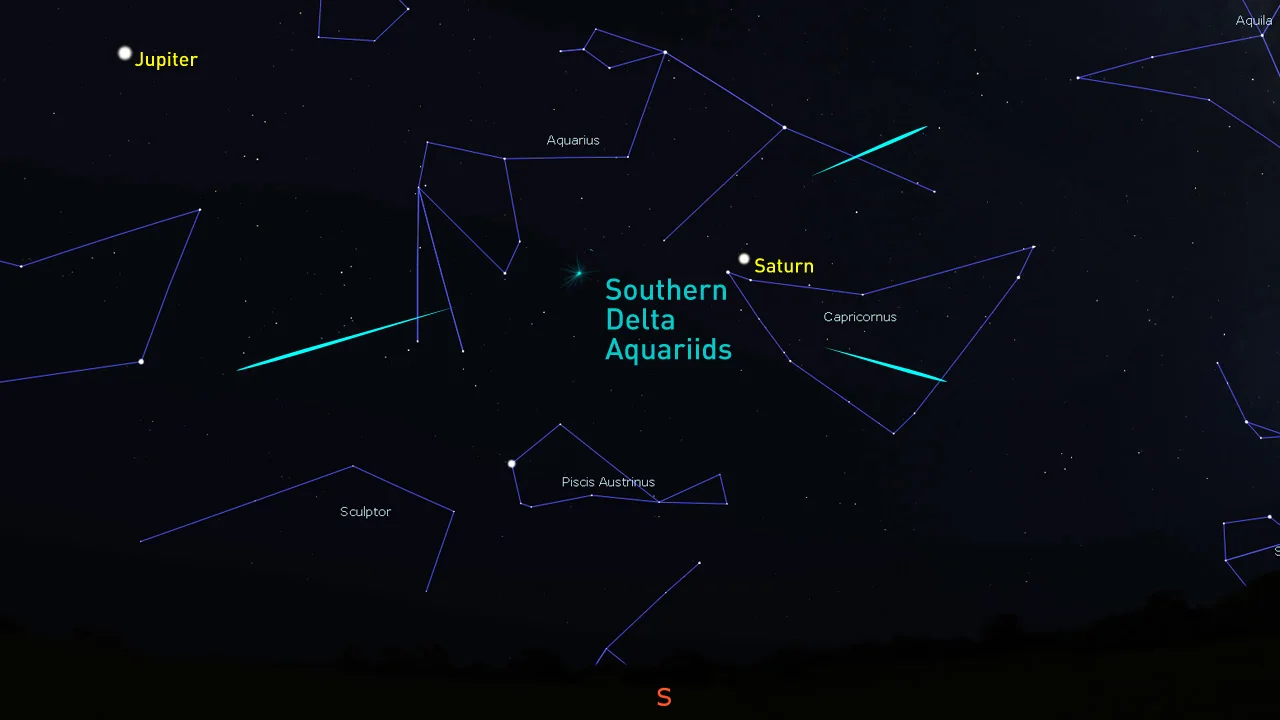
The Southern Delta Aquariids meteor shower gets its name from the fact that its radiant is near the constellation Aquarius. This view of the night sky shows the radiant's location in the predawn sky on July 29, 2022. Credit: Stellarium/Scott Sutherland
This year's peak for the southern delta Aquariids is at a fortunate time, right after the New Moon. So there will be no moonlight to spoil our view of the meteor shower. Watch for the meteors to show up after 10 p.m. local time (when the radiant rises above the horizon), and the best viewing time tends to be between 3 a.m. and 4 a.m., when the radiant is directly to the south, and highest in the sky.
Earth plunges into the second of the two debris streams on July 17. Left behind by Comet 109P/Swift-Tuttle, the meteoroids from this stream put on one of the best meteor displays in the northern hemisphere — the Perseid meteor shower.
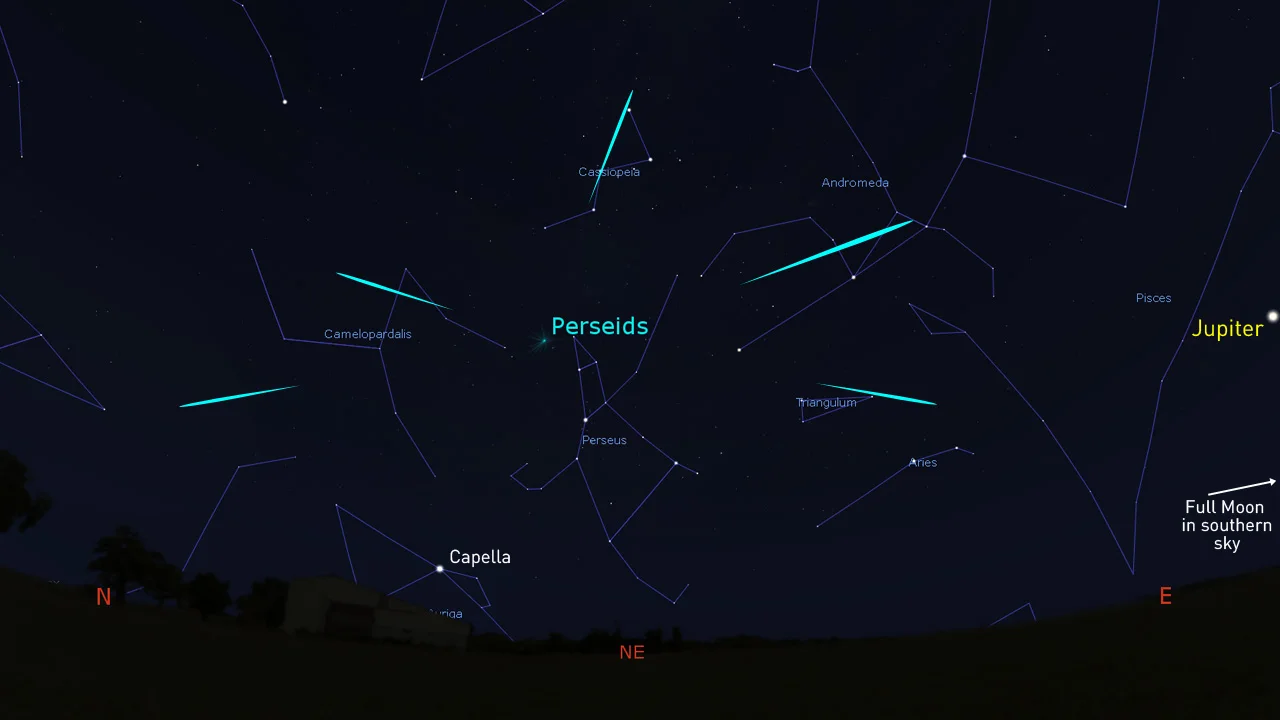
The location of the Perseids radiant at midnight on August 12-13. Credit: Stellarium/Scott Sutherland
During the peak of the Perseids — on the night of August 12-13 — the shower can deliver up to 100 meteors per hour. Sometimes even more!
The Perseids radiant — the position the meteors appear to originate from in the sky — is a special one. Positioned in the northeastern sky, it never sets below the horizon at this time of year. So, there's no waiting for this meteor radiant to rise. Observers need only wait for the Sun to completely set.
Unfortunately, in 2022, the peak of the Perseids occurs just one night after the August Full Moon. With the bright Moon in the sky all night long, it will likely reduce the number of meteors that we can see. However, since the meteor shower's radiant is centred in the northeastern part of the sky, observers can minimize this interference by keeping the Moon out of their direct line of sight.
Even so, it may be best to observe this meteor shower during the two week before the peak. There will be fewer meteors occurring, overall. However, with at least some portion of the night without the Moon in the sky, we will have better viewing conditions to see them.
Fortunately, though, the Perseids have the distinction of having the greatest number of fireball meteors of any annual meteor shower. Fireballs are so bright they can outshine the planet Venus, and they cut through any light pollution from the Moon.
Watch: Perseid fireball captured on camera
The overlap between these two meteor showers is nearly perfect. Both start off slowly at a few meteors per hour, with the Perseids beginning two days after the southern delta Aquariids. Both showers ramp up the number of meteors as their peaks approach, and then the numbers taper off until August 24.
There's two major differences between them, though. The first is the timing of their peaks. The Perseids reach their max about two weeks after the southern delta Aquariids. The second is that the Perseids produce far more meteors. In fact, even two weeks before it reaches its maximum, the Perseid meteor shower can easily match the peak output of the southern delta Aquariids.
So, at the end of July, when the southern delta Aquariids are giving us their best show out of the southern sky, it's possible to see just as many Perseid meteors streaming out of the northeastern sky at the same time! Plus, as an added bonus, the southern delta Aquariids tend to taper off slowly for the first couple of nights after the peak, while the number of Perseid meteors will continue to slowly ramp up.
So, the end of July and beginning of August may be the best time to go meteor watching this summer.
TIPS FOR WATCHING A METEOR SHOWER
Meteor showers are events that nearly everyone can watch. No special equipment is required. In fact, binoculars and telescopes make it harder to see meteor showers, by restricting your field of view. However, there are a few things to keep in mind so you don't miss out on these amazing events.
The three best practices for observing the night sky are:
Check the weather,
Get away from light pollution, and
Be patient.
Clear skies are essential. Even a few hours of cloudy skies can ruin your chances of watching an event such as a meteor shower. So, be sure to check The Weather Network on TV, on our website, or from our app, and look for my articles on our Space News page, just to be sure that you have the most up-to-date sky forecast.
Next, you need to get away from city light pollution. If you look up into the sky from home, what do you see? The Moon, a planet or two, perhaps a few bright stars such as Vega, Betelgeuse and Procyon, as well as some passing airliners? If so, there's too much light pollution in your area to get the most out of a meteor shower. You might catch an exceptionally bright fireball if one happens to fly past overhead, but that's likely all you'll see. So, to get the most out of your stargazing and meteor watching, get out of the city. The farther away you can get, the better.
Watch: What light pollution is doing to city views of the Milky Way
For most regions of Canada, getting out from under light pollution is simply a matter of driving outside of your city, town or village until a multitude of stars is visible above your head.
In some areas, especially in southern Ontario and along the St. Lawrence River, the concentration of light pollution is too high. Getting far enough outside of one city to escape its light pollution tends to put you under the light pollution dome of the next city over. The best options for getting away from light depend on your location. In southwestern Ontario and the Niagara Peninsula, the shores of Lake Erie can offer some excellent views. In the GTA and farther east, drive north and seek out the various Ontario provincial parks or Quebec provincial parks. Even if you're confined to the parking lot after hours, these are usually excellent locations from which to watch (and you don't run the risk of trespassing on someone's property).
If you can't get away, the suburbs can offer at least a slightly better view of the night sky. Here, the key is to limit the amount of direct light in your field of view. Dark backyards, sheltered from street lights by surrounding houses and trees, are your best haven. The video above provides a good example of viewing based on the concentration of light pollution in the sky. Also, check for dark sky preserves in your area.
When viewing a meteor shower, be mindful of the phase of the Moon. Meteor showers are typically at their best when viewed during the New Moon or Crescent Moon. However, a Gibbous or Full Moon can be bright enough to wash out all but the brightest meteors. Since we can't get away from the Moon, the best option is just to time your outing right, so the Moon has already set or is low in the sky. Also, you can angle your field of view to keep the Moon out of your direct line of sight. This will reduce its impact on your night vision and allow you to spot more meteors.
Once you've verified you have clear skies and you've limited your exposure to light pollution, this is where being patient comes in.
For best viewing, your eyes need some time to adapt to the dark. Give yourself at least 20 minutes, but 30-45 minutes is best for your eyes to adjust from being exposed to bright light.
Note that this, likely more than anything else, is the one thing that causes the most disappointment when it comes to watching a meteor shower.
If you step out into your backyard from a brightly lit home and looking up for a few minutes, you might be lucky enough to catch a rare bright fireball meteor. However, it's far more likely that you won't see anything at all. Meteors may be streaking overhead, but it takes time for our eyes to adjust, so that we can actually pick out those brief flashes of light. Waiting for at least twenty minutes, while avoiding sources of light during that time (streetlights, car headlights and interior lights, and smartphone and tablet screens) dramatically improves your chances of avoiding disappointment.
Sometimes, avoiding your smartphone or tablet isn't an option. In this case, set the display to reduce the amount of blue light it gives off and reduce the screen's brightness. That way, it will have less of an impact on your night vision.
You can certainly gaze into the starry sky while you are letting your eyes adjust. You may even see a few of the brighter meteors as your eyes become accustomed to the dark.
Once you're all set, just look straight up and enjoy the view!
--
Thumbnail photo credit: Allexxandar/Getty Images - stock photo. Creative #: 826077456.











